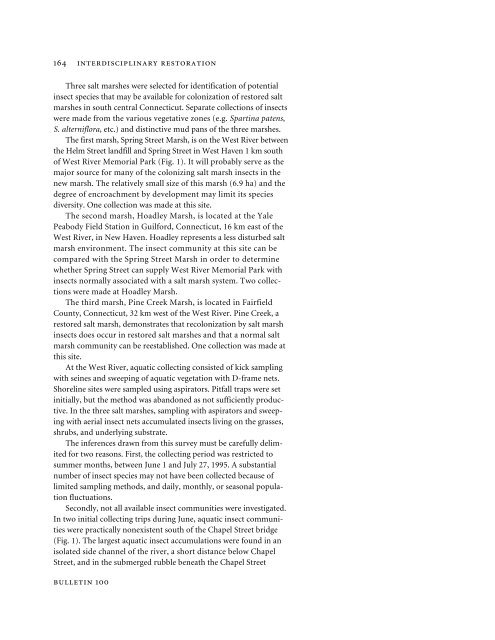Aquatic Insects of the West River and Salt Marshes ... - Yale University
Aquatic Insects of the West River and Salt Marshes ... - Yale University
Aquatic Insects of the West River and Salt Marshes ... - Yale University
Create successful ePaper yourself
Turn your PDF publications into a flip-book with our unique Google optimized e-Paper software.
164 INTERDISCIPLINARY RESTORATIONThree salt marshes were selected for identification <strong>of</strong> potentialinsect species that may be available for colonization <strong>of</strong> restored saltmarshes in south central Connecticut. Separate collections <strong>of</strong> insectswere made from <strong>the</strong> various vegetative zones (e.g. Spartina patens,S. alterniflora, etc.) <strong>and</strong> distinctive mud pans <strong>of</strong> <strong>the</strong> three marshes.The first marsh, Spring Street Marsh, is on <strong>the</strong> <strong>West</strong> <strong>River</strong> between<strong>the</strong> Helm Street l<strong>and</strong>fill <strong>and</strong> Spring Street in <strong>West</strong> Haven 1 km south<strong>of</strong> <strong>West</strong> <strong>River</strong> Memorial Park (Fig. 1). It will probably serve as <strong>the</strong>major source for many <strong>of</strong> <strong>the</strong> colonizing salt marsh insects in <strong>the</strong>new marsh. The relatively small size <strong>of</strong> this marsh (6.9 ha) <strong>and</strong> <strong>the</strong>degree <strong>of</strong> encroachment by development may limit its speciesdiversity. One collection was made at this site.The second marsh, Hoadley Marsh, is located at <strong>the</strong> <strong>Yale</strong>Peabody Field Station in Guilford, Connecticut, 16 km east <strong>of</strong> <strong>the</strong><strong>West</strong> <strong>River</strong>, in New Haven. Hoadley represents a less disturbed saltmarsh environment. The insect community at this site can becompared with <strong>the</strong> Spring Street Marsh in order to determinewhe<strong>the</strong>r Spring Street can supply <strong>West</strong> <strong>River</strong> Memorial Park withinsects normally associated with a salt marsh system. Two collectionswere made at Hoadley Marsh.The third marsh, Pine Creek Marsh, is located in FairfieldCounty, Connecticut, 32 km west <strong>of</strong> <strong>the</strong> <strong>West</strong> <strong>River</strong>. Pine Creek, arestored salt marsh, demonstrates that recolonization by salt marshinsects does occur in restored salt marshes <strong>and</strong> that a normal saltmarsh community can be reestablished. One collection was made atthis site.At <strong>the</strong> <strong>West</strong> <strong>River</strong>, aquatic collecting consisted <strong>of</strong> kick samplingwith seines <strong>and</strong> sweeping <strong>of</strong> aquatic vegetation with D-frame nets.Shoreline sites were sampled using aspirators. Pitfall traps were setinitially, but <strong>the</strong> method was ab<strong>and</strong>oned as not sufficiently productive.In <strong>the</strong> three salt marshes, sampling with aspirators <strong>and</strong> sweepingwith aerial insect nets accumulated insects living on <strong>the</strong> grasses,shrubs, <strong>and</strong> underlying substrate.The inferences drawn from this survey must be carefully delimitedfor two reasons. First, <strong>the</strong> collecting period was restricted tosummer months, between June 1 <strong>and</strong> July 27, 1995. A substantialnumber <strong>of</strong> insect species may not have been collected because <strong>of</strong>limited sampling methods, <strong>and</strong> daily, monthly, or seasonal populationfluctuations.Secondly, not all available insect communities were investigated.In two initial collecting trips during June, aquatic insect communitieswere practically nonexistent south <strong>of</strong> <strong>the</strong> Chapel Street bridge(Fig. 1). The largest aquatic insect accumulations were found in anisolated side channel <strong>of</strong> <strong>the</strong> river, a short distance below ChapelStreet, <strong>and</strong> in <strong>the</strong> submerged rubble beneath <strong>the</strong> Chapel StreetBULLETIN 100
















